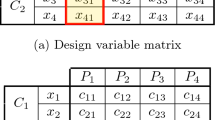Abstract
This paper proposes a method for finding a robust solution to the problem of joint product family and supply chain design. Optimizing product design and the supply chain network at the same time brings substantial benefits. However, this approach involves decisions that can generate uncertainties in the long term. The challenge is to come up with a method that can adapt to most possible environments without straying too far from the optimal solution. Our approach is based on the generation of scenarios that correspond to combinations of uncertain parameters within the model. The performance of designs resulting from these scenario optimizations are compared to the performance of each of the other design scenarios, based on their probability of occurrence. The proposed methodology will allow practitioners to choose a suitable design, from the most profitable to the most reliable.








Similar content being viewed by others
References
Baud-Lavigne, B., Agard, B., & Penz, B. (2011). A MILP model for joint product family and supply chain design. In Proceedings of the International Conference on Industrial Engineering and Systems Management (IESM’2011), Metz, France (pp. 889–897). International Institute for Innovation, Industrial Engineering and Entrepreneurship (I4e2). ISBN 978-2-9600532-3-4.
Baud-Lavigne, B., Agard, B., & Penz, B. (2012). Mutual impacts of product standardization and supply chain design. International Journal of Production Economics, 135(1), 50–60.
Chan, F. T. S., Chung, S. H., & Choy, K. L. (2006). Optimization of order fulfillment in distribution network problems. Journal of Intelligent Manufacturing, 17(3), 307–319.
Chen, H.-Y. (2010). The impact of item substitutions on production–distribution networks for supply chains. Transportation Research Part E: Logistics and Transportation Review, 46(6), 803–819.
Childerhouse, P., & Towill, D. R. (2004). Reducing uncertainty in European supply chains. Journal of Manufacturing Technology Management, 15(7), 585–598.
Dani, S. (2009). Predicting and managing supply chain risks. In Supply Chain, Risk (pp. 53–66). Berlin: Springer.
El Hadj Khalaf, R., Agard, B., & Penz, B. (2010). An experimental study for the selection of modules and facilities in a mass customization context. Journal of Intelligent Manufacturing, 21(6), 703–716.
ElMaraghy, H., & Mahmoudi, N. (2009). Concurrent design of product modules structure and global supply chain configurations. International Journal of Computer Integrated Manufacturing, 22(6), 483–493.
Jiao, J., Simpson, T., & Siddique, Z. (2007). Product family design and platform-based product development: A state-of-the-art review. Journal of Intelligent Manufacturing, 18(1), 5–29.
Klibi, W., Martel, A., & Guitouni, A. (2010). The design of robust value-creating supply chain networks: A critical review. European Journal of Operational Research, 203(2), 283–293.
Kristianto, Y., Helo, P., & Jiao, R. (2013). Mass customization design of engineer-to-order products using benders’ decomposition and bi-level stochastic programming. Journal of Intelligent Manufacturing, 24(5), 961–975.
Lamothe, J., Hadj-Hamou, K., & Aldanondo, M. (2006). An optimization model for selecting a product family and designing its supply chain. European Journal of Operational Research, 169(3), 1030–1047.
Meepetchdee, Y., & Shah, N. (2007). Logistical network design with robustness and complexity considerations. International Journal of Physical Distribution and Logistics Management, 37(3), 201–222.
Mohammadi Bidhandi, H., & Mohd Yusuff, R. (2011). Integrated supply chain planning under uncertainty using an improved stochastic approach. Applied Mathematical Modelling, 35(6), 2618–2630.
Pan, F., & Nagi, R. (2010). Robust supply chain design under uncertain demand in agile manufacturing. Computers and Operations Research, 37(4), 668–683.
Parvaresh, F., Husseini, S. M. M., Golpayegany, S. A. H., & Karimi, B. (2012). Hub network design problem in the presence of disruptions. Journal of Intelligent Manufacturing, 1–20. doi:10.1007/s10845-012-0717-7.
Peidro, D., Mula, J., Poler, R., & Lario, F. (2009). Quantitative models for supply chain planning under uncertainty: A review. The International Journal of Advanced Manufacturing Technology, 43(3), 400–420.
Schulze, L., & Li, L. (2009). Location-allocation model for logistics networks with implementing commonality and postponement strategies. Proceedings of the International MultiConference of Engineers and Computer Scientists, 2, 1615–1620.
Shahzad, K. M., & Hadj-Hamou, K. (2013). Integrated supply chain and product family architecture under highly customized demand. Journal of Intelligent Manufacturing, 24(5), 1005–1018.
Shapiro, J. F. (2001). Modeling the Supply Chain. Boston: Duxbury Resource Center.
Shimizu, Y., Fushimi, H., & Wada, T. (2011). Robust logistics network modeling and design against uncertainties. Journal of Advanced Mechanical Design, Systems, and Manufacturing, 5(2), 103–114.
Taguchi, G. (1986). Introduction to quality engineering: Designing quality into products and processes. Asian Productivity Organization.
Wie, M. V., Stone, R. B., Thevenot, H., & Simpson, T. (2007). Examination of platform and differentiating elements in product family design. Journal of Intelligent Manufacturing, 18(1), 77–96.
Zhang, X., Huang, G., Humphreys, P., & Botta-Genoulaz, V. (2010). Simultaneous configuration of platform products and manufacturing supply chains: Comparative investigation into impacts of different supply chain coordination schemes. Production Planning and Control, 21(6), 609.
Author information
Authors and Affiliations
Corresponding author
Rights and permissions
About this article
Cite this article
Baud-Lavigne, B., Bassetto, S. & Agard, B. A method for a robust optimization of joint product and supply chain design. J Intell Manuf 27, 741–749 (2016). https://doi.org/10.1007/s10845-014-0908-5
Received:
Accepted:
Published:
Issue Date:
DOI: https://doi.org/10.1007/s10845-014-0908-5




